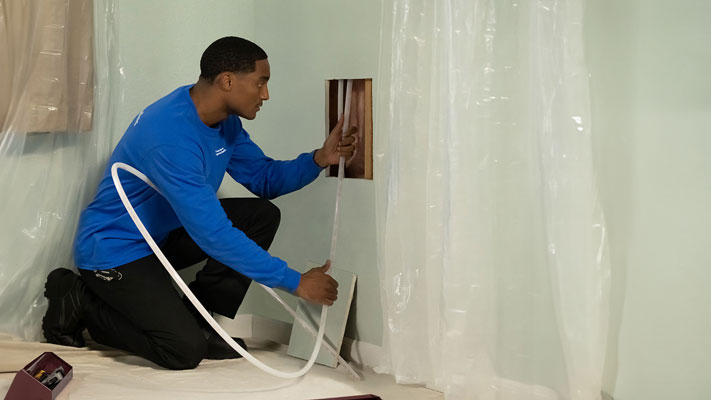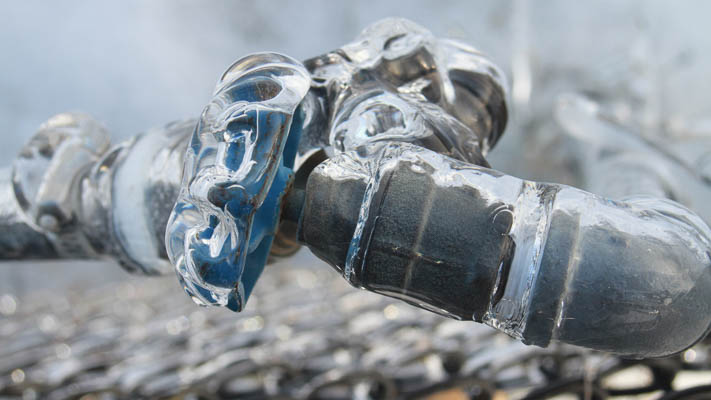What Are the First Signs That Pipes Are Frozen?
Frozen pipes don't always announce themselves with a dramatic burst. Often, the signs are subtle at first. The most common warning signals include:
- Little to no water flow: If you turn on a tap and only a trickle (or no water at all) comes out, it's a clear sign there may be ice inside the pipe.
- Visible frost: On exposed sections of plumbing, frost or ice buildup on the outside of the pipe is a strong indication the inside has frozen.
- Strange noises: Banging, clanking, or gurgling sounds when you run water can mean that ice is obstructing flow and water is forcing its way through small openings.
It's important to pay attention to these early red flags. A frozen pipe doesn't always burst immediately, but as ice expands and pressure builds, the risk of rupture increases. Acting quickly can prevent bigger problems down the line.
How Do I Check If My Pipes Are Frozen?
If you suspect your pipes are a frozen, checking your home's pipes can help confirm the problem. Start by running water from several taps around your home. If some fixtures flow normally while others are weaker, the frozen section is likely in the line serving only that part of the house.
Examine exposed plumbing in basements, crawl spaces, or along exterior walls. Look for visible frost, bulging, or condensation on the pipe surface. These physical cues often pinpoint the frozen area.
If you can safely access the section, you can gently test it with your hand. A pipe that feels unusually cold compared to other sections may be blocked with ice. To reduce risk while thawing, temporarily shut off the main water supply and open nearby faucets. This relieves pressure and helps prevent bursts as the ice melts.
Are Certain Pipes More Likely to Freeze?
Not all pipes face the same risk in freezing conditions. Some areas of the home are especially vulnerable:
- Unheated spaces: Attics, crawl spaces, basements, and garages often lack insulation and expose pipes to low temperatures.
- Exterior walls: Pipes routed along outside walls may have minimal protection from the cold.
- Outdoor spigots and hose bibbs: These are common freeze points, especially if they're not winterised or fitted with frost-free valves.

Pipe material also plays a major role. Rigid options such as copper and CPVC are far more likely to crack when water inside them freezes.
By contrast, PEX (cross-linked polyethylene) is flexible and can expand slightly with ice, making it much more tolerant in cold weather. We have a detailed article about why PEX is the most freeze-resistant material for sudden cold spells.
Understanding which parts of your plumbing system are most exposed helps you take targeted preventive action before temperatures drop.
How Can I Prevent My Pipes From Freezing Again?
Preventing frozen pipes is about insulation, preparation, and keeping water moving. Some of the most effective methods include:
- Insulate vulnerable pipes: Use foam insulation sleeves or tape to wrap exposed lines in unheated spaces.
- Seal drafts: Close off gaps around windows, doors, and wall penetrations to keep cold air from reaching your plumbing.
- Maintain indoor heat: Keep your home's temperature consistent, even overnight or when you're away.
Other preventative measures include letting faucets drip slightly during extreme cold to keep water moving and relieve pressure, turning off and draining hose bibs before winter sets in, and installing heat tape on pipes that are difficult to reroute or insulate.
Consider Repiping With PEX
If you're dealing with repeated freeze problems, another long-term solution is repiping with PEX. Unlike copper or CPVC, PEX is flexible enough to expand slightly if the water inside it freezes, making it far more tolerant of sudden cold snaps.

Many homeowners in colder regions choose PEX to lower the risk of future bursts and minimize costly water damage. You can read more in our article on how to keep your home's plumbing from freezing.
Contact us to have one of our local repipe consultants explain your PEX repipe options and provide a consultation and quote, either in-home or remotely.
Get your free estimate today
With over 75,000 repipes completed, we've perfected our One-Stop Repipe™ for your home.
Get a Quote for Repiping With Freeze-Resistant PEX
At Repipe Specialists, we've helped thousands of homeowners protect their plumbing from freeze damage by repiping with durable Uponor PEX-A tubing. Since 1991, our focus has been on delivering reliable, long-term solutions. Our customers consistently share how much smoother and easier their repipe experience was than expected. From the first consultation to the final inspection, our crews are known for speed, cleanliness, and professionalism.
- Speed: Our repipe crews typically complete a repipe in a day, returning on another day for wall patching.
- Convenience: Through our One-Stop Repipe™ Process, we handle everything from permits, to wall patching, to inspections.
- Cleanliness: Our crews are trained to protect your home while working (we cover all surfaces with protective sheeting), and to clean up fully at the end of each day.
- Peace of Mind: Repipe Specialists is a fully licensed plumber in every state we operate in, and we back all of our repipes with a lifetime warranty.
- Financing programs: To help take the sting out of unplanned repipe expenses, we offer several financing programs.
- Price: As a specialist that performs hundreds of repipes a week, we can deliver high-quality repipes at a lower cost vs generalist plumbers. Our quotes typically range from $4,500 to $15,000 depending on the size and complexity of your project. We have an article that covers repipe cost factors in detail.
Schedule a free in-home consult, and one of our local repipe consultants will walk you through all your options. You'll receive a fixed-price, written quote so there are no surprises. Don't wait for another cold snap to test your pipes - upgrade to freeze-resistant PEX and leave frozen pipes in the past.

